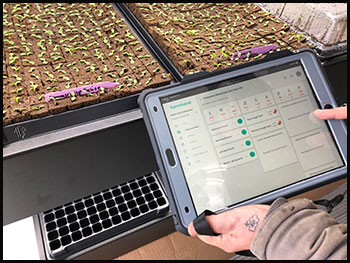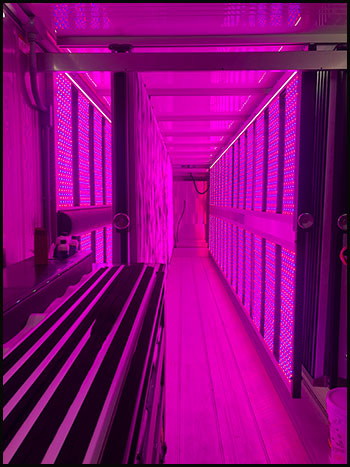There’s a new addition near the play hills at Cheyenne Mountain Zoo: a brand-new shipping container farm, equipped with the latest hydroponic vertical growing technology, including blue and red LED grow lights with specialized wavelengths for leafy green production.
The newly installed high-tech horticulture house is the next step in CMZoo’s goal toward a more secure, autonomous way to source fresh leafy greens for animals. In July 2021, the Zoo established its first shipping container farm, and this second farm is a continuation of the horticulture team’s testing phase.

“We’re excited to learn this new system and to see what works best compared to our existing shipping container farm, which guests can see right next door,” said Julia Zoltowsky, horticulture curator at CMZoo. “This setup looks a lot different, and we have high hopes for improving our production and efficiency with resources like water and energy.”
Guests peering through the glass door at the end of the farm, which is a metal freight container, will immediately notice a big difference: the plants are hanging sideways on vertical panels, rather than sitting upright on horizontal shelves. There’s also a nursery in the new farm, so the horticulture team can grow produce from seeds then transfer them to the hanging grow panels within the same environment.
“The new system is fully automated,” said Zoltowsky. “We use a computer system that gives us a ‘recipe’ for each plant species we’re growing. We input the type of plant in each panel or nursery section, and the system tells us the unique light, water, nutrient and spacing needs, and then delivers those settings on a programmed schedule.”
Anyone who visits CMZoo knows lettuce plays a big role in the Zoo’s success in connecting people to animals, notably the 17-member giraffe herd. Guests can get eye to eye with the giraffe and hand-feed them lettuce every day – whether they’re in their barn or out in their yards – for $3 per lettuce bundle, or $5 for two bundles.
It fluctuates throughout the year, but on average, the Zoo uses more than 3,500 heads of romaine lettuce per month for animal diets. It’s a small part of the giraffes’ diet, but it’s a huge part of the guest experience.
After a satisfactory testing period, the long-term plan is to purchase additional shipping container farms, which will be located in a renovated guest entryway and complement a renovated giraffe habitat. With processes fine-tuned and more farms in place, the Zoo hopes to be able to source approximately 50 percent of the lettuce for its giraffe feeding experience. Even longer term, the Zoo hopes to grow 80 percent of all fresh produce for its animals in farms like this one.
The testing phase allows the horticulture team to learn the high-tech programs, controlled by an iPad on-site and through remote surveillance and software off-site. It will also give them a chance to make sure the ‘recipes’ for each plant are really working, and that the equipment is reliable. There’s a lot to test.
“Part of each plant’s recipe for success includes optimal lighting settings,” said Zoltowsky. “The horticulture team can control the lighting, watering and nutrients remotely, and thanks to cameras inside the shipping container, we can check on the plants without even entering the farm. When things are this high-tech, we anticipate some glitches, but everything is going really smoothly so far.”

At the end of the December, the farm’s first seedlings were moved over to the grow panels, so the first test harvest is well underway. Once the plants are big enough to leave the nursery, they’re moved to a hanging panel which holds the plants sideways with sponges and wicking strips made of thick felt. The plants are held in place by strips of sponge. The panels drip water onto wicking strips that reach the plants’ roots. The plants absorb the water and nutrients that drip down each panel onto the felt wicking strips. At the bottom of the panel, excess water is collected and moved back through the system.
The horticulture team enters data into the computerized system like when seedlings are planted or when they are transferred to a grow panel. The idea is that the system does the rest, including directing the team to harvest on specific dates. The farm has a dedicated Ethernet system and back-up power, so a power or internet outage shouldn’t impact the plants.
“We can see a ton of information through the system, which will hopefully help us be most efficient with our resources,” said Zoltowsky. “Hydroponic growing means you grow plants in water, without soil, so you have more autonomy over how much nutrients go into a plant.”
When plants grow in the ground, farmers work to provide the perfect nutrient balance, which is difficult because there are nutrients in the ground, nutrients in the soil added to the ground and nutrients added throughout the growing process.
“You can test the soil, but it’s hard to find a balance that allows you to grow the plant with exactly what it needs,” said Zoltowsky. “This makes it simple to know exactly what the plant is eating, and that’s how we know our animals are eating safe and healthy produce – because we grew it ourselves.”
The original shipping container farm will continue to be tested. Once the team masters the new shipping container farm, the plan is to dedicate it to lettuce production while the original farm allows them to continue experimenting with growing herbs, browse and other parts of animals’ diets.
“We think we can produce about 3,960 heads of lettuce per month once we’re up and running,” said Zoltowsky. “We want to start slowly while we’re learning this technology, the computer system, and getting new staff on board. We have invested a lot of time and energy into researching the best system for us, and we’re excited to share it with our visitors.”
Guests can see the new and original shipping container farms near the play hills, across from the Grizzly Grill, at Cheyenne Mountain Zoo.

